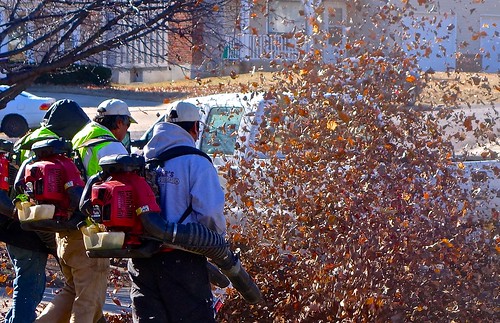
A group of students at Johns Hopkins University have made a quieter leaf blower – though it would be better to have a non-petrol one. CC-licensed photo by Dean Hochman on Flickr.
You can sign up to receive each day’s Start Up post by email. You’ll need to click a confirmation link, so no spam.
There’s another post coming this week at the Social Warming Substack on Friday at 0845 UK time. Free signup.
A selection of 9 links for you. Blowin’ in the wind. I’m @charlesarthur on Twitter. On Threads: charles_arthur. On Mastodon: https://newsie.social/@charlesarthur. Observations and links welcome.
New Arm-powered Surface Pro and Surface Laptop aim directly at Apple Silicon Macs • Ars Technica
Andrew Cunningham:
»
If at first you don’t succeed, try, try again.
Microsoft has announced a pair of new devices powered by Qualcomm’s Snapdragon X Plus and X Elite processors. They’re far from Microsoft’s first PCs with Arm processors in them—2012’s original Surface, the Surface Pro X, and the Surface Pro 9 with 5G have all shipped with Arm’s chips instead of Intel’s or AMD’s. But today’s new Surface Pro and Surface Laptop are the first Arm devices to be the primary Surface offerings rather than a side offering, and they’re the first to credibly claim that they can both outperform comparable Intel- and AMD-designed chips while offering better battery life, a la Apple’s M1 chip in 2020.
One caveat that I hadn’t seen mentioned in Microsoft’s presentation or in other coverage of the announcement, though—Microsoft says that both of these devices have fans. Apple still uses fans for the MacBook Pro lineup, but the MacBook Air is totally fanless. Bear that in mind when reading Microsoft’s claims about performance.
All of these devices meet Microsoft’s minimum hardware requirements for its new “Copilot+ PC” initiative, which is meant to support more on-device processing for AI-powered activities like chatbots and image generation. All of the devices are available for pre-order now and will begin arriving on June 18.
…Microsoft’s messaging is muddy. The devices declare on a “key specs” sheet that they will give users up to 20 or 22 hours of local video playback. But the full specs sheet claims a much shorter 13 and 15 hours for “active web usage.” Microsoft quotes 18 and 17 hours of “typical device usage” for the Surface Laptop 5, but it’s unclear how “typical device usage” and “active web usage” compare to each other since Microsoft says they’re different tests.
«
Nobody’s buying laptops based on comparative performance between Windows and Mac. It’s the OS first, and everything else afterwards. The only question is whether this makes Windows virtualisation on macOS more likely, and on that, there’s no sign.
unique link to this extract
ChatGPT suspends AI voice that sounds like Scarlett Johansson • The Guardian
Nick Robins-Early:
»
OpenAI removed a heavily promoted voice option from ChatGPT on Monday, following a widespread reaction to the flirtatious, feminine voice that sounded almost identical to Scarlett Johansson.
The company used the voice, which it calls “Sky”, during its widely publicized event last week debuting the capabilities of the new ChatGPT-4o artificial intelligence model. Researchers talked with the AI assistant to show off Sky’s personable and responsive affectations, which users and members of the media immediately compared to Johansson’s AI companion character in the 2013 Spike Jonze film Her.
Even OpenAI’s CEO, Sam Altman, seemed to suggest that the vocal design was intentionally mimicking Johansson’s character, posting a one-word tweet after the presentation that simply said “her”. Less than a week later, OpenAI felt compelled to explicitly clarify that Sky was not based on Johansson. The company published a blogpost about Sky’s creation and claimed that the company values the voice acting industry.
“Sky’s voice is not an imitation of Scarlett Johansson but belongs to a different professional actress using her own natural speaking voice,” the blogpost read. “To protect their privacy, we cannot share the names of our voice talents.”
While many commentators remarked on Sky’s similarities to Johansson in Her – including Johansson’s husband and Saturday Night Live cast member, Colin Jost, during a segment on the show’s season finale – others questioned why the voice was so fawning and gendered. “You can really tell that a man built this tech,” the Daily Show host Desi Lydic joked last week. “She’s like, ‘I have all the information in the world, but I don’t know anything.’”
«
Scarlett Johansson issued a statement on Monday suggesting that OpenAI did approach her to be the voice (she considered it and declined), approached her again two days ahead of the release, released it and thus forced her to hire lawyers who got it taken offline.
You can tell that a man built it, indeed.
unique link to this extract
How AI bots and voice assistants reinforce gender bias • Brookings
Caitlin Chin-Rothmann and Mishaela Robison:
»
As artificial bots and voice assistants become more prevalent, it is crucial to evaluate how they depict and reinforce existing gender-job stereotypes and how the composition of their development teams affect these portrayals. AI ethicist Josie Young recently said that “when we add a human name, face, or voice [to technology] … it reflects the biases in the viewpoints of the teams that built it,” reflecting growing academic and civil commentary on this topic. Going forward, the need for clearer social and ethical standards regarding the depiction of gender in artificial bots will only increase as they become more numerous and technologically advanced.
Given their early adoption in the mass consumer market, U.S. voice assistants present a practical example of how AI bots prompt fundamental criticisms about gender representation and how tech companies have addressed these challenges. In this report, we review the history of voice assistants, gender bias, the diversity of the tech workforce, and recent developments regarding gender portrayals in voice assistants.
…Voice assistants illustrate how Silicon Valley’s approach to gender-based harassment is evolving. In 2017, Leah Fessler of Quartz analyzed how Siri, Alexa, Cortana, and Google Assistant responded to flirty, sexual comments and found they were evasive, subservient, and sometimes seemingly thankful (Table B in the article).
When replicating this exercise in July 2020, we discovered that each of the four voice assistants had since received a rewrite to respond to harassment in a more definitively negative manner. For example, Cortana responded by reminding the user she is a piece of technology (“I’m code”) or moving on entirely. Similarly, Siri asked for a different prompt or explicitly refused to answer.
«
The progress from 2017 to 2020 is quite encouraging.
unique link to this extract
FBI arrests man for generating AI child sexual abuse imagery • Courtwatch News
Seamus Hughes and Samantha Cole:
»
Steven Anderegg, a 42 year old man from Holmen, Wisconsin, allegedly used Stable Diffusion, a text-to-image generative AI model, to create “thousands of realistic images of prepubescent minors,” prosecutors said in an announcement on Monday. “Many of these images depicted nude or partially clothed minors lasciviously displaying or touching their genitals or engaging in sexual intercourse with men. Evidence recovered from Anderegg’s electronic devices revealed that he generated these images using specific, sexually explicit text prompts related to minors, which he then stored on his computer.”
He then allegedly communicated with a 15-year-old boy, describing his process for creating the images, and sent him several of the AI generated images of minors through Instagram direct messages. In some of the messages, Anderegg told Instagram users that he uses Telegram to distribute AI-generated CSAM. “He actively cultivated an online community of like-minded offenders—through Instagram and Telegram—in which he could show off his obscene depictions of minors and discuss with these other offenders their shared sexual interest in children,” the court records allege. “Put differently, he used these GenAI images to attract other offenders who could normalize and validate his sexual interest in children while simultaneously fueling these offenders’ interest—and his own—in seeing minors being sexually abused.”
This marks one of the first known instances where the FBI has charged someone for using AI to create child sexual abuse material.
«
Regrettably, almost surely won’t be the last.
unique link to this extract
How I made Google’s “web” view my default search • Tedium
Ernie Smith:
»
Ever use a de-Googled Android phone? Here’s a de-Googled Google, or as close to one as you’re going to get on the google.com domain.
It’s such a questionably fascinating idea to offer something like this, and for power searchers like myself, it’s likely going to be an amazing tool. But Google’s decision to bury it ensures that few people will use it. The company has essentially bet that you’ll be better off with a pre-parsed guess produced by its AI engine.
It’s worth understanding the tradeoffs, though. My headline aside, a simplified view does not replace the declining quality of Google’s results, largely caused by decades of SEO optimization by website creators. The same overly optimized results are going to be there, like it or not. It is not Google circa 2001—it is a Google-circa-2001 presentation of Google circa 2024, a very different site.
But if you understand the tradeoffs, it can be a great tool. Power users will find it especially helpful when doing deep dives into things. However, is there anything you can do to minimize the pain of having to click the “Web” option buried in a menu every single time?
The answer to that question is yes. Google does not make it easy, because its URLs seem extra-loaded with cruft these days, but by adding a URL parameter to your search—in this case, “udm=14”—you can get directly to the Web results in a search.
«
There is a way to make it automatically add the URL parameter to the search, as the article explains. If you’re getting annoyed with the AI suggestions, then this is your way forward.
unique link to this extract
How will Google make money when search just gives you the answer? • Threads
»
edmundlee: I have a dumb question for all the smart tech reporters out there. How will
@google make money when search doesn’t take you to a site but just gives you the answer? Search advertising accounts for nearly 60% of all Alphabet revenue. So it’s going to be replaced by subscriptions? I still don’t get it.crumbler [Casey Newton, tech journalist who writes the Platformer email): They’ll show fewer ads on web pages, more (and more lucrative) ads on the SERP [search engine results page], and also scoop up the affiliate fees that used to go to all the websites publishing ‘best laptop’ lists. Once they have a working agent they’ll take various fees for being your travel agent / personal shopper etc
«
Which makes a lot of sense. Google just wants to roll it all up so it’s the only site on the internet.
unique link to this extract
As clicks dry up for news sites, could Apple News be a lifeline? • Semafor
Max Tani:
»
Like many digital publishers, The Daily Beast was struggling at the end of 2023. Facebook, long a primary driver of clicks to the publication, had turned away from news. Search traffic had become increasingly erratic, as Google adjusted its algorithm to combat a flood of AI-powered junk. The site’s paid subscription program had atrophied since Donald Trump left office.
But it had a new lifeline: Apple.
Late last year, the digital news tabloid (where I worked from 2018 to 2021 as a media reporter) entered into Apple’s partnership program, called Apple News+. The program made all of the publication’s buzziest exclusives available to paying Apple subscribers, behind Apple’s own paywall. And the impact for a mid-sized news site was immediate, putting the Beast on track to make between $3-4m in revenue this year from Apple News alone — more than its own standalone subscription program, and without much additional cost.
The Beast is hardly alone in its increased reliance on the iOS news aggregator. The free version of Apple News has been a source of audience attention for news publishers since it launched in 2015. But while many publishers have come to the conclusion that traffic has less business value than they once thought, they’re still desperate for revenue. Executives at companies including Condé Nast, Penske Media, Vox, Hearst, and Time all told Semafor that Apple News+ has come to represent a substantial stream of direct revenue.
A spokesperson for Time said that Apple News has become “one of our most important partners and delivers 7-figures of revenue for TIME annually,” adding that the publication garnered five million unique visitors from Apple News last month. The revenue and audience numbers have been similar at major Condé Nast publications, including Wired and Vanity Fair. As significant as the partnership has been for the Daily Beast, it’s been even bigger for its larger corporate sister Dotdash Meredith, which runs the portfolio of magazines purchased by Daily Beast parent company IAC in 2021.
«
Just in case it hadn’t clicked, seven-figure revenues are in the millions. Astonishing if Apple News has somehow become the new saviour of the news industry: as Google changes its algorithm and kills the smaller sites (which are otherwise being killed by Dotdash Meredith), maybe this is the new port in a storm.
unique link to this extract
Interview of the week: Meredith Whittaker, AI ethics expert • The Innovator
Jennifer L. Schenker talks to the woman who is president of Signal, the messaging app, but also has been a faculty director of the AI Now Institute, and formerly at Google:
»
Q: There is concern that large language models are being dominated by a handful of Silicon Valley and Chinese players. What problems does this pose? And where does Europe fit into this picture?
MW: This is not just a concern, this is the reality. The AI industry is dominated by a handful of monopoly players, largely based in the US (whose dominant cloud companies have about 70% of the global market). The best hope for AI “startups” in this environment is to be acquired or enter into another kind of encumbered partnership with one of the US-based ‘hyperscalers.’ Meaning, there is no path to market that isn’t through the current giants. The EU and others need to recognize this, and seriously prepare for a future where these largely unaccountable and obscure companies, which provide core infrastructure for computation globally in addition to licensing powerful AI services, could be pressured by a more hostile, more isolationist US government.
Q: In the early days of the Internet the mantra was “Privacy is dead. Get over it.” Is it game over or do you believe we can regain control of our data and our privacy in the age of GenAI? 7. You are speaking at VivaTech in May. What will be your main message to the audience?
MW: The ‘Internet’ is not even a century old, and the current version of commercial networked computation is only a few decades old, emerging out of the 1990s and the neoliberal zeitgeist of that time which saw the market as the rightful arbiter of social and political life, and saw regulations–even those that would protect privacy and curb massive corporate surveillance–as inhibiting this free market. Out of the 1990s, the surveillance business model emerged, and the massive amounts of data, compute, and monopolistic platforms that we now confront were shaped during this time. We cannot treat this peculiar, contingent business model as somehow natural or inevitable. We can regain control – of course we can! – and we can make necessary and meaningful changes to these infrastructures.
«
She’s an interesting interviewee.
unique link to this extract
College students engineer a leaf blower silencer that blew Black & Decker away • Hot Hardware
Nathan Ord:
»
A team of undergraduate engineering students at Johns Hopkins University has created a quieter leaf blower using a simple barrel attachment that acts like a suppressor on a gun. This attachment is expected to hit shelves in the next two years, reducing the traditional shrill cry of leaf blowers worldwide to a gentler blowing noise.
Last September, a team of four students from Johns Hopkins were presented with a challenge: “Take a leaf blower, but make it quiet.” The project began with figuring out how the leaf blower was built and its individual components, further “analyzing all of its the noises and why it made them.” Once complete, the team spent a lot of time contemplating improvements, creating solutions, and binning many options that did not fit the bill. Team member Andrew Palacio explained to JHU Hub that “The sound that comes out of this leaf blower is very complicated and it contains a lot of different frequencies,” so ultimately, it took around 40 versions of the solution that was finally landed upon, a suppressor-like leaf blower-attachment.
The final design cuts out the high-pitched, more annoying frequencies by roughly 12dB which is 94% quieter over the original sound pressure level, and the overall noise was reduced by 2dB making the leaf blower around 37% quieter. So, while it is a quieter machine overall, the noise that is present will also be more bearable than standard, non-suppressed leaf blowers.
«
Although the utility of any but electric leaf blowers (which would by nature be silent) is in question. They’re incredibly polluting, not only in noise but also the oil/petrol mix they burn.
unique link to this extract
| • Why do social networks drive us a little mad? • Why does angry content seem to dominate what we see? • How much of a role do algorithms play in affecting what we see and do online? • What can we do about it? • Did Facebook have any inkling of what was coming in Myanmar in 2016? Read Social Warming, my latest book, and find answers – and more. |
Errata, corrigenda and ai no corrida: none notified









